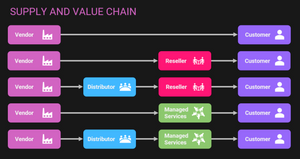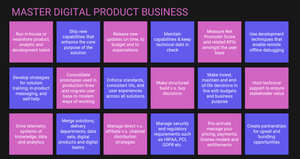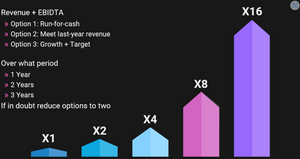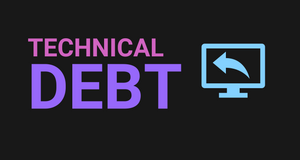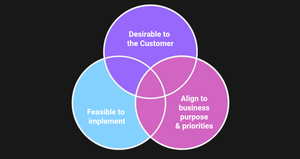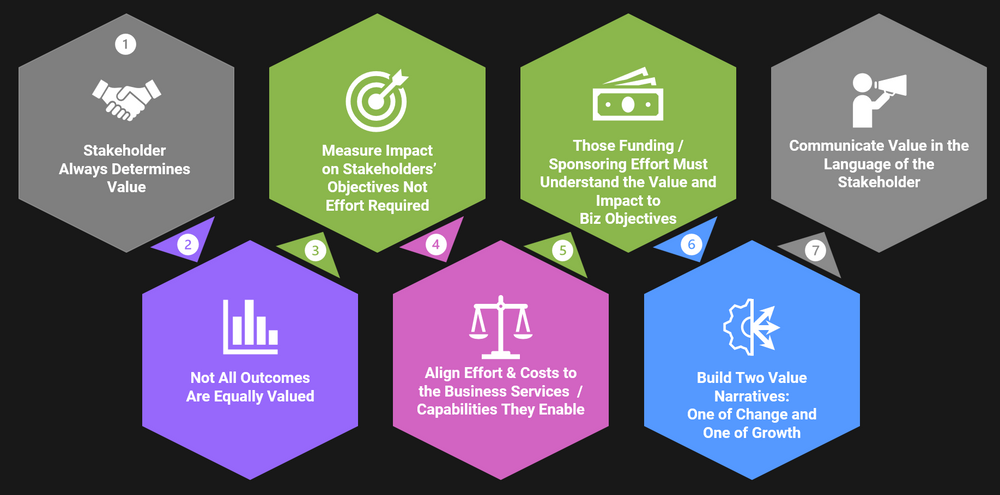I continue seeing discussions with stakeholders and decision-makers centred around feature/function rather than value-to-customer plus value-to-business. This way of discussing value limits the business from confidently engaging in timely continuous improvement initiatives that matter and be better.

The principles of demonstrating value to stakeholders apply to all types of projects/efforts:
- Digital transformation,
- Product capability prioritisation (New Feature v.s. Bug Fix v.s. Easier v.s. Smarter etc.)
- Business Process improvement.
When dealing with an initiative that requires economic support/effort (resources & time to scope, engage stakeholders, develop and implement), business stakeholders must make sense of and believe in the value of the outcome enabled by your initiative. This understanding is even more critical when business leaders are continuously pressured by competing departments actively lobbying to prioritise their projects, ideas, features or initiatives.
1. Stakeholder Always Determines Value

While product managers, product owners, builders, providers and subject matter experts can provide a mechanism to determine what is of value, it is critical to balance that mechanism with equalised inputs from:
- Business Stakeholders
- User/Customer Stakeholders.
Arguments typically tend to have a bias towards one side to the detriment of the other. When identifying what is valuable, aligning internal and external needs, outcomes, costs and efforts to ensure that you realise the required objectives, benefits and results.
2. Not All Outcomes Are Equally Valued

Value is in the eye of the beholder. Ensure you engage your initiative's business and consumer stakeholders to better articulate the effort-to-return or return-on-initiative (ROI). My preference is to continually engage with the business leadership first to understand immediate business priorities such as:
- Cost savings
- Revenue increase
- Support call decrease
- Productivity gains
- Friction elimination in critical areas
- etc
This, in turn, helps you guide stakeholders wanting to engage in a series of transformative initiatives towards the ones that are most likely to garner support and investment. Short-term business priorities lean towards Quarterly Goals or Revenue Growth initiatives over savings and productivity gains as they tend to be more quantifiable and easy to measure. This does not mean that efficiency gains through process improvements are less valuable. It only means that you must be better prepared to argue against "What happens if we do not do this now?"
3. Measure Impact on Stakeholders' Objectives, Not Effort Required or Resources Consumed
This is controversial as it can be misunderstood, especially in digital transformation projects.
All too often, we spend more effort discussing if it is needed versus the cost of actually implementing the solution. Yes, one can also argue the lack of discussion can drive unnecessary costs in undesired outcomes/impact.
To speed up this aspect, focus more on the value of the outcome as defined by your stakeholders. Your role is to enable this transformation and represent that value with your stakeholders rather than on your own. See your work as an enabler of value realisation.

Even more controversial, I find that while the business leadership wants to understand the effort and effort-details of technical work, they also tend to panic and misunderstand the metrics around effort, work and technological output. Technical and process work that impacts cross-functional teams is never simple. Yet, the business expects simplicity because details are hidden from leadership in the first place to avoid that panic reaction.
When this happens, try to bring down work efforts into streamlined units of work that is understandable to the stakeholder.
4. Align Effort & Costs to the Business Services / Capabilities They Enable
Business and Customer Stakeholders will better understand the value delivered (by your systems, product, feature etc.) when the risks and costs to improve with that capability align with the business services and capabilities they provide.

Costs on their own tend to be limiting, boring, and just considered a risk. Try to frame the delivered capabilities in terms of the outcome area, e.g.:
- Cost per transaction of a critical business service (Cost per unit analysis)
- Time to deliver transaction of a critical business service (Actual time to ship in terms of dollars, emails, clarifications, errors etc.)
Avoid deep dives into technologies and capabilities and use language that focuses on actionable outcomes that support:
- Critical business processes that drive more business
- Higher volume of work
- Increased customer engagement and satisfaction
- Faster decision making
5. Those Funding / Sponsoring Effort Must Understand the Value and Impact of Business Objectives
"We all have a boss":
- An employee may report to a line manager.
- A CEO reports to a Board of Directors.
- Board of Directors report to Investors that, can include a mix of private owners, Bank Loan Covenants, Private Equity (PE) and Venture Capitalists (VC).
- Banks, PEs and VCs report to their own investment fund contributors.
- ...so on and so forth...
Finance and Business Leaders funding or acting as an executive sponsor to a project/initiative need to understand the value and impact of their time/effort/allocation on the business outcomes they are set to achieve in the short-medium-longer term targets.
Engage the economic stakeholders as early as possible to ensure initiative scope and definition effort is put into work areas that matter and align with their required business outcomes. Wherever possible, make the spend justification a collective effort to define and get buy-in with stakeholders that are funding and delivering with that modernised capability/process.

Funding will typically lag or be held back for further definition when the overall strategy is misaligned with expectations or past investments. It will also lag if the definition of success does not align between Funding Stakeholder and User Stakeholder.
While unclarity will drive towards a more "project" way of engaging work, a better way is to agree with the funding stakeholder on how to spend is ideally best placed to align work to those Value areas.
6. Build Two Value Narratives: One of Change and One of Growth/Transform

Your initiative can either enable the business stakeholders to better:
- Operate and run smoother, faster and less error-prone versions of existing processes
- Delivery Growth through new product value or highly differentiated capabilities
When an initiative covers both, manifest your value in those terms. Cover both:
- When reporting OPERATIONAL improvements, focus on cost-per-unit and speed-to-outcome benefits.
- When reporting GROWTH, focus on price for performance of gain (savings or revenue)
7. Communicate value in the Language of the Stakeholder
This will sound obvious, however many times, I found myself guilty of communicating in a language I thought was simple, where it was complex for the intended audience
Simplicity is in the eye of the beholder. General guidance includes for you:
- Use business language, not technical terminology and acronyms.
- Keep it short and relevant.
- Designed to deliver clear, relevant and speedy decision-making.
- Wherever possible, use actionable insights that support critical business processes.
What I learned and highly recommended:
- Share what you will be communicating with team members that report to the target stakeholders for feedback. What they will share tends to be very eye-opening and relevant to improve your messaging style and approach.
Adapt these rules for your organisation
- See what applies to your organisation?
- If needed, customise the rule to make it better and more effective for you
- How can you improve your communications (primarily through rules 3 and 7)
- What else can you do differently to communicate a clearer and more impactful value-driven message that engages and excites?
This post is inspired by the book "The art of Business Value" by Mark Schwartz, "The 7 Rules of Business Value of IT" by Robert Naegle and earlier personal works, including Work Value Elements (WAVE) and how to align priorities to work that matters and has impact.

